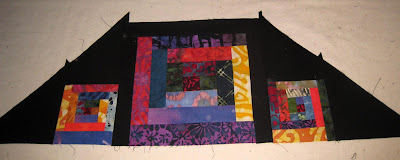I ended up making the fix to this quilt - mainly for 2 reasons
1 - the inch lost from the missing sashing meant my top wasn't square - either I needed to fix it or trim the rest of the quilt back.
2 - the error really bothered me!
The top edges on 2 sides are an inch too narrow
Julie loves the quilt and was happy for me to either fix it or leave it alone - she just wants to get it home! In the overall scheme of things, I spent roughly 2 weeks putting this top together and I hope this quilt is going to be around for a long time to come, so another couple of hours work to fix it is worth the effort.
I will admit to some cheating though. I didn't after all pull the whole thing apart, but simply took off the offending triangles and pieced in the extra lengths of sashing. A shame really as I went to all sorts of trouble to get the long sashings to the right length without having to piece them!
Pieced sashing
Also, this is a very simple quilt and the fact that I had problems with it really caused me to think about where I'm going with all this. The quilts in this series are going to get more and more complicated and by book 6 they are going to be mind-blowingly difficult (for me) to make. If I want to continue in my quest to become a competent quilt-maker I need to understand the basics. So I'm going to make this quilt again and do it correctly. Carrie has emailed me pointing out where I went wrong
If you remember this picture from the last blog post - you'll see where I got confused. With the side triangles on, I couldn't get the top sashing on. Carrie corrected me on this - those points on the side triangles need to be trimmed off! Dahhh simple really, and at this point in my 'lessons' I should have realised this.
The re-make of this quilt will be the as is, with no changes in size to the pattern. The only difference will be the amount of fabrics. There is a quilting store in Hobart with a great range of 1930's prints but they sell them only by the metre or as fat 8th's, as these prints are popular for scrappy quilts. So I'll be using 24 fat 8th's instead of 12 FQ's for the fabrics. Hopefully this time I'll get it right!
FRONT LOADER WASHING
Because I made Julie's quilt from 90% batik fabrics, and according to the book, batiks are the most likely to bleed in the wash (along with hand dyes and deep dark colours, which make up the other 10% of fabrics in this quilt), I made an extra block to test for colour runs which was also useful for playing with quilting designs. I never pre-wash my quilting fabrics, so a test wash was essential.
I have a front loading washing machine, which means I can't use most of the products or techniques recommended for quilt washing. My machine is fairly old and doesn't have a soak cycle either. In fact the machine uses very little water and soap, the quilt isn't submerged when being washed, but gently sloshes around in there getting very wet but always moving.
The way I wash my finished quilts is to use a gentle cold water only cycle and a tiny bit of washing powder. If I didn't use washing powder I'd worry about the blue marking lines not being completely removed and returning later as brown marks. I can't use the gentle soaps and pastes recommended for quilt washing either, as my machine requires a special low-sudsing powder. Pre-soaking in the sink then moving to the machine is a concern, as a sopping wet quilt is not something which likes to be handled too much. So far I've had no problems with washing any of my quilts. I have, however stopped hovering around the machine, looking in the little window checking for brightly coloured water! If the colours did run there would be nothing I could do anyway - I can't get the quilt out of there until it's done.
So I played with some quilting on my sample and threw it in the washing machine with some natural coloured calico and a Colour Catcher sheet. I also had a packet of colour run remover on hand!
The fabrics didn't bleed at all. The calico has no hint of any colour and even the colour catcher only turned a light grey rather than a rainbow of colours. Call me surprised (but pleased).
I don't like the quilting design I chose to test. The fabrics and batting are both cottons and have shrunk considerably, which I normally prefer, but too much texture doesn't suit this quilt. Nor do I like the variegated thread. For the quilting, Julie and I have chosen to do simple scallops (which Julie calls rainbows), use invisible nylon on top and the variegated thread in the bottom, which should show up well on the black batting.
Off to the sewing room for more fabric cutting and a new Cabin in the Cotton quilt.

































.jpg)


